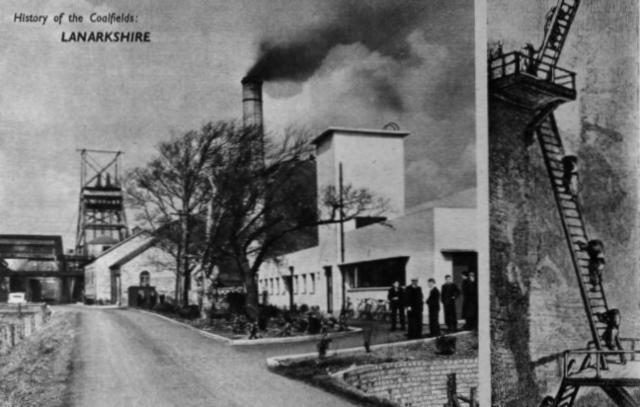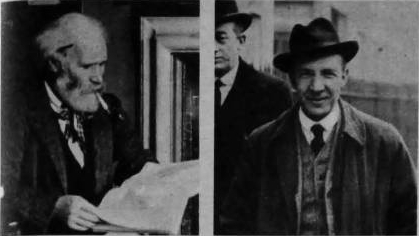History of the Coalfields: Lanarkshire
The “Black Country” of Scotland
Nature endowed the County of Lanark with a bountiful measure of mineral wealth. The exploitation of this caused the heavy industries to be concentrated within the county's boundaries, and so Lanarkshire became the "Black Country" of Scotland.
The Scottish coalfield forms a more or less continuous belt stretching from the west coast at Ayr to the east coast of Fife. That part of the belt commonly described as the Central Coalfield is almost wholly contained in Lanarkshire. Within this area was found the most valuable of the Scottish coal seams, besides many seams of Black-land ironstone.
The fact that many of the coals were of high class splint made Lanarkshire the seat of the iron-smelting industry. The field forms a large irregular shaped basin with its centre near Uddingston. This basin contained the full thickness of coal measures with many thick and valuable seams. To the south-west the large Dechmont fault, with a throw amounting at some points to about 600 fathoms, cuts off the coal productive strata abruptly. Around the fringes the carboniferous Limestone series tomes to the surface and a number of important collieries are operating there.
The importance and value of the Lanarkshire coalfield can be realised from the fact that in the late nineteenth century more than half of the Scottish output came from that field. While Lanarkshire still holds the position of premier coal-producing county of Scotland she holds it with a steadily diminishing lead. For this there are two main reasons, the increasing development of Fife and the Lothians, and, unfortunately, the exhaustion of her own rich fields.
Coal production in Lanarkshire did not assume great importance till well on in the nineteenth century. In the Lothians, and especially in Fife, the digging of coal as an ancillary to salt manufacture was in operation in the twelfth century. There are no records of such early mining of coal in Lanark. One of the earliest coal mines in the county was near Hamilton, on the banks of the river Avon, a tributary of the Clyde. Here the Duke of Hamilton worked the valuable seam known as the Ell coal by mines from the surface. These workings must have been on a comparatively small scale.
In 1645, because of the loss of one of the mines through flooding, the output did not suffice to serve the needs of Hamilton Palace and coal had to be brought from other districts. From these mines on the Avon braes the coal was transported by a railway to a point half a mile distant from Hamilton. The selling price of coal at this depot was 3s. 9d. per ton. Hawkers with donkey carts delivered the coal to residents of Hamilton in loads of from ten to twelve cwt. at a cost of 4d. per cwt.
The early Avonbraes Mines were under the charge of a man named James Wilson, and each succeeding generation of this family has given leaders to the mining industry. The present generation is represented by H.M. Chief Inspector of Mines Mr. A. M. Bryan, a direct descendant of this old-time manager.
Since then coal has continued to be worked in the Avonbraes area by Quarter Collieries. One of these pits, sunk in 1815, is still in operation and must be among the oldest working pits in Scotland. At Quarter Pits at different periods the names of two widely different personalities have appeared on the wages book - James Keir Hardie, collier; and Harry Lauder, pony driver.
It is claimed that at the edge of the basin in the neighbourhood of Cambuslang coal mining was in operation at a very early date. During the coal stoppage in 1921 opencast work at Kirkburn disclosed the workings of an old mine of unknown and ancient date. Picks made of stone were found in these workings.
Pits are known to have been worked on the Borgie Burn. In the workings of one were found wooden shovels and picks with iron tips. At a pit near Cambuslang Cross was installed a Newcombe steam engine, which was among the first in Scotland. The duplicate of this engine was in use at Farme Colliery, Rutherglen, until recent years. It is now in the Kelvinside Museum, Glasgow.
An early record of coal mining at Cambuslang concerns a man who in 1659 was charged at the instance of the kirk with having "imprecated a curse" on a local employer. He confessed his guilt, advancing in mitigation of his offence the plea that he had been unbalanced by news of his father s death in the "coal heughs."
The development of the large coalfield in central Lanarkshire did not take place till the nineteenth century; before this there were doubts as to its existence. In the basin between Hamilton, Uddingston and Cambuslang there is an extensive area covered by "Red Metals," which early geologists classified as belonging to the old red sandstone. This error may have hindered the development of the field.
It was in or about 1870 that intensive developments started, stimulated by the construction if the railway in 1876. A characteristic of the Lanarkshire coalfield was the large number of smaller leaseholds into which it was divided. There must be few coalfields in Britain which contain a greater number of small or moderately sized pits.

Today and yesterday: Hopetoun Colliery, Lanarkshire, with a clean, modern layout; and (right) girl bearers of coal in Scotland a hundred years ago, dragging their loads up ladders in 300-foot shafts
 | Two famous names have appeared on the pay-roll at Quarter Pits, in the Avonbraes area : Keir Hardie was a collier there, and Harry Lauder a pony driver |
CALLOUS LANDLORDS
In a paper read to the Royal Scottish Society of Arts in 1864 Dr. David Landale, an eminent mining engineer of that time, made some pungent criticism of this policy. "In the Wishaw district for instance," he writes, "landlords having a fine seam with a railway alongside divide their fields into patches of 100 acres which they let at £1,000 a year fixed rent or optional royalty of 1s. per ton." He continues to criticise "these needy landlords who look upon themselves as mere life-renters, desiring to haul out all they can in their own day, caring little for futurity."
No doubt Dr. Landale's approach to the problem was that of the mining engineer rather than the politician, but in the main he was correct. While the policy did much to induce intensive development, thereby creating a short-lived prosperity, it was by no means the method to promote efficiency or economy in working. It did much to hasten the end, and has undoubtedly aggravated the problem now confronting this coal¬field.
The rapid development caused a great influx of workers, with consequent need for housing. This led to the hasty building of villages, sometimes on undesirable sites, and too often destitute of amenities. This has left another problem, a social one, as great and as difficult of solution as the mining and industrial problems.
LOSS BY FLOODING
A factor which has contributed to the decline the Lanarkshire coalfield is the loss through flooding of two extensive areas which at one time contained many collieries and produced considerable outputs of coal. One tract extends from Coatbridge to Glasgow, the other is in the Wishaw-Cleland district. All the pits in these areas were close together, and in many cases the workings were connected. As one colliery after another ceased working the burden of pumping fell upon those remaining, until it became so great that the plant could not cope with the growth.
The reopening of these districts has been the cause of much controversy and the subject of at least two investigations. In 1936 the Commissioner for Special Areas in Scotland made a grant towards the cost of a survey of the Coatbridge-Glasgow tract. The mining engineer who carried out the investigation advised against the unwatering and resumption of work. It was estimated that the coal reserves in the submerged area amounted to 25,000,000 tons, mostly in patches surrounded by extensive wastes and some of it of doubtful quality.
The surface in this area has been built upon, and even with solid stowage, which would not prevent subsidence but merely minimise it, considerable damage would be done to houses, water mains, sewage works and railways. Owing to the contour of the field and the presence of faults it would be difficult to arrange for a central pumping station.
In 1943, at the instance of the County Council of Lanark an investigation into the feasibility of reopening the Wishaw-Cleland area was made by a well-known mining engineer. He estimated that the reserves of coal amounted to over 8,000,000 tons. To work the area two collieries were suggested, one with an output of 1,000 tons per day and a life of twenty years, the other with a daily output of 400 tons extending over twenty-eight years. No optimistic forecast was made of costs and a warning of damage to surface property was given.
The majority report of the Scottish Coalfields Committee stated: "The working of the coal in the two flooded tracts cannot in our view be justified until no other coal remains which can be worked more easily and more economically."
The productive coal measures in Lanarkshire can naturally be divided into two. The upper part contained the thicker and more valuable coal seams. It was during the intensive working of these that the Lanarkshire coal output reached its maximum. The seams were easy to work and a ready market was nearly always available. The lower half of the measures contained a number of seams much thinner but of good commercial value.
On the exhaustion of the thick seams the pits were generally sunk to the lower group. Economic conditions compelled the adoption of mechanical methods. Through the enterprise of owners and management, together with the co-operation and adaptability of the workmen, Lanarkshire became the cradle of machine mining and was able to compete with districts more favourably placed.
BEST DAYS PAST
Undoubtedly the best days of Lanarkshire as a coal-producing unit are over. The output has fallen considerably and will continue to do so during the next thirty years. There remains a substantial reserve of coal to be won. The Scottish Coalfields Committee estimated in 1944 that the coal resources of the county were 603,000,000 tons. The greater part of this is contained in the Limestone Coal Group around the fringes of the Central Field.
There are many valuable seams in this group. At one time high hopes were entertained that these seams would be found under the coal measures throughout the Central Field. Deep borings, however, have proved that these seams are either wholly absent or are so thin as to be unworkable.
In their estimate of the resources the Committee did not take into account what they describe as "the relatively small reserves near the surface." These reserves, however, are considerable and can make a worthwhile contribution to the output for some years to come. It has been proved that such patches can be economically won by modern methods. Development of these in Lanarkshire would help to bridge the gap that must exist until the new collieries planned in the east of Scotland are under production. It would also absorb the labour locally until the essential work of providing homes for the workers in the new fields can be accomplished. [Coal, November 1948]